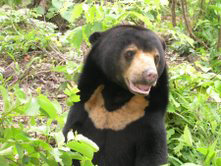Sun Bears reclassified by IUCN as Vulnerable
Sun Bears reclassified by IUCN as Vulnerable
Jeremy Hance, special to mongabay.com
November 13, 2007
The world’s smallest bear has been recently classified as vulnerable by the IUCN due to habitat loss and poaching. Co-chair of the IUCN Bear Specialist Group, Dave Garshelis, states that “although we do not have any reliable population estimates for the sun bear, or any of the other Asian bears for that matter, we fear that bears in Southeast Asia are declining at a particularly rapid rate due to extensive loss of forest habitat combined with rampant poaching.”
The threats to the Sun Bear change according to its region. In Malaysia, Indonesia, Sumatra, and Borneo, Sun Bears are threatened mostly by habitat loss. Widespread deforestation is occurring due to the increasing production of palm oil for biofuels and other products. Illegal logging and forest fires are also common in these areas. In nations where deforestation is less of a problem, poaching is the main threat. Nations including Myanmar, Thailand, and Vietnam have long histories of illegal poaching of the Sun Bear for its gall bladder, used as a traditional Chinese medicine, and its paws which are considered a delicacy. The gall bladder is in such demand that it can fetch a price 18 times that of gold.
 |
The Sun Bear can be recognized by more than its small size. On its chest the Sun Bear sports a large yellow marking which gives the bear its name. The bear also sports an extremely long tongue to gather honey, which is why it is also known as the honey bear.
With the reclassification of the Sun Bear as vulnerable, the IUCN now lists six of eight bear species as threatened with extinction. The Giant Panda is listed as endangered, while the Asiatic Black Bear, Sloth Bear, Andean Bear, and Polar Bear are all considered vulnerable. Only the Brown Bear and American Black Bear are considered by the IUCN as least concern’ species. The American Black Bear is by far the most populous. IUCN reports a population of 900,000, which it states is more than double the populations of all the other bear species added together.







